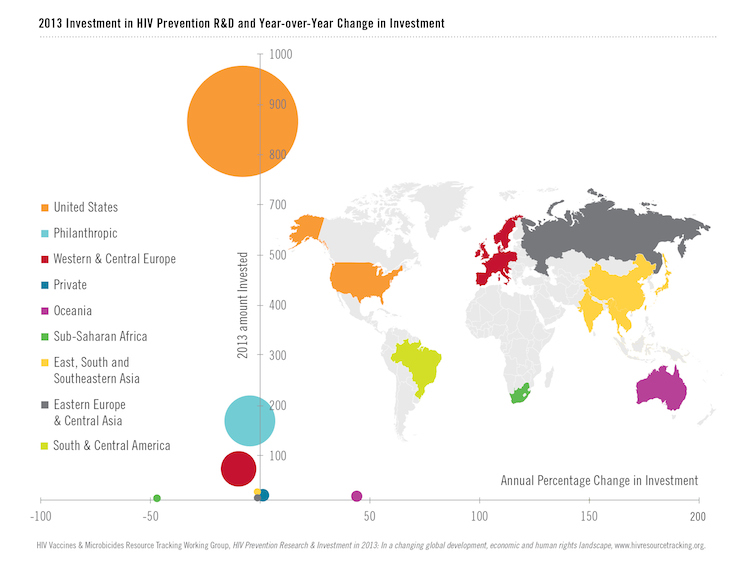Contacts
AVAC: Mitchell Warren,[email protected], +1‐914‐661‐1536
Kay Marshall, [email protected], +1-347-249-6375
IAVI: Barbara Rosen, [email protected], + 1.646.206.9331
New funding sources needed to sustain innovative HIV prevention R&D
Vancouver, Canada, 17 July 2015 – The last decade has seen investment in HIV prevention R&D move beyond bench science and clinical trials to include significant funding for implementation research for proven prevention options, such as pre-exposure prophylaxis (PrEP) and voluntary medical male circumcision (VMMC), according to a new report from the HIV Vaccines and Microbicides Resource Tracking Working Group.
Understanding how to ensure a new product reaches those most in need though effective programs is a critical part of HIV prevention research. Positive results from a number of clinical trials of daily oral PrEP led to approval by the US Food and Drug Administration (FDA) and initial guidelines from the World Health Organization (WHO) in 2012. Since then the rallying cry for PrEP researchers and advocates has been “PrEP works, but we must find out how to deliver it effectively.”
In 2014, a number of PrEP demonstration and implementation projects in different settings and populations were underway to help find how to best deliver PrEP. The Working Group found that investment in these projects and several ongoing studies testing long-acting PrEP formulations led to a significant increase in funding for PrEP in 2014 – US $48 million, up from US $36 million in 2013.
“We are at a crucial point in the history of the AIDS response. Sustained investment in research has led to major scientific advances in the past few years,” said Luiz Loures, deputy executive director, Programme, Joint United Nations Programme on HIV/AIDS (UNAIDS). “Now we need to fast-track implementation and ensure that results are made available to people at scale and with urgency.”
HIV Prevention Research & Development Funding Trends 2000–2014: Investment Priorities To Fund Innovation In An Evolving Global Health And Development Landscape is the 11th annual report by the Working Group, a collaboration among AVAC, UNAIDS, and the International AIDS Vaccine Initiative (IAVI). The report summarizes investment in HIV prevention research across eight prevention options, as well as HSV-2 vaccine and HIV cure and therapeutic vaccine R&D. For the first time this year’s report also tracks investment in R&D for multipurpose prevention technologies (MPTs), an increasing focus of prevention research. The report was released today ahead of the 8th IAS Conference on HIV Pathogenesis, Treatment and Prevention in Vancouver, Canada. Breakdowns by prevention category are available in the full report at www.hivresourcetracking.org.
A decade of sustained funding, but a decline in number of funders
Overall funding for HIV prevention research was relatively stable over the past decade, peaking at US $1.31 billion in 2012 and remaining essentially flat in 2014 at a total of US $1.25 billion from public-sector, philanthropic and industry investors. In 2014, as in previous years, the US government – primarily through the US National Institutes of Health (NIH) – was by far the largest public sector funder and the Bill & Melinda Gates Foundation remained the largest philanthropic funder. Together they provided 83 percent of total funding. In 2014 there was a decline in the number of individual funders overall, and the number of philanthropic funders has decreased from a high of 30 in 2010 to 16 in 2014.
Calling for an expanded and diversified investment base, the Working Group warned that funding reductions from one or two major donors could imperil the progress of HIV prevention research over the next decade, when several new HIV prevention options – including HIV vaccines, injectable PrEP, new microbicide formulations and multipurpose prevention technologies – now in early stage human trials, may be moving to large scale efficacy trials. These large trials would likely require significant new investment.
“Ending AIDS once and for all will require critical investments in prevention research and development,” said IAVI CEO Margie McGlynn. “This report highlights funders whose commitment should be celebrated, but also underscores the need for public-sector and philanthropic stakeholders to re-engage to the benefit of individuals, communities and economies worldwide. The links between improvements in health and sustainable development are clear.”
The last decade has seen major breakthroughs in HIV prevention R&D, not only in results, but also early stage research and improvements on the way large-scale trials can be conducted, paving the way for innovative new trials and major gains in HIV prevention R&D in the coming decade.
“Innovative science needs innovative funding. We need an expanded and more diverse global cadre of funders who will be involved in and dedicated to advancing HIV prevention R&D and ensuring that new options like PrEP do not sit on the shelf unused because we don’t know how to effectively deliver them,” said Mitchell Warren, AVAC executive director.
The report and infographics on prevention research investment are online at www.hivresourcetracking.org and on social media with #HIVPxinvestment.
The HIV Vaccines and Microbicides Resource Tracking Working Group is composed of AVAC, the International AIDS Vaccine Initiative (IAVI) and the Joint United Nations Programme on HIV/AIDS (UNAIDS). The Working Group has been tracking investment in HIV prevention research since 2004. The Working Group generates estimates of R&D investment that can be compared year to year, across separate technologies and across funding sources, helping assess the impact of public policies aimed at accelerating scientific progress and providing facts for advocacy. This effort provides transparency for funders, policy makers and HIV/AIDS advocates to understand and track investment flows year-to-year.


